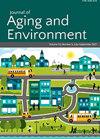巴基斯坦公共养老院老年人口生活满意度的保护因素:对社会政策的启示
IF 1
Q3 GERONTOLOGY
引用次数: 3
摘要
巴基斯坦的老年人口不断增长,面临着养老院设施短缺的问题。迫切需要为贫穷的老年人开发国营养老院,但在规划养老院时,要确定目前居住的居民生活满意度的保护因素。我们的样本包括来自四个城市的六个公共部门养老院的139名老年居民。定性研究结果强调了人口老龄化对生活满意度的影响因素和应对策略。双变量回归结果显示,当老年人对生活总体质量(AOR 5.99;95% ci: 2.38-7.06);(ii)卫生(aor2.50;95% ci: 1.02-4.14);(iii)财务(AOR 1.98;95% ci: 0.67-3.72);宗教和精神协会(AOR 1.90;95% ci: 0.81-2.45);(v)学习机会(AOR 1.02);95% ci: 0.42-2.41)。最后,我们提出了四项显著的社会政策建议,以提高生活在养老院的老年人的生活满意度。本文章由计算机程序翻译,如有差异,请以英文原文为准。
Protective Factors for Life Satisfaction in Aging Populations Residing in Public Sector Old Age Homes of Pakistan: Implications for Social Policy
Abstract Aging people in Pakistan are a growing population who face a shortage of old age home facilities. There is critical need to develop state-run old age homes for poor older people but to plan them while identifying protective factors for life satisfaction in currently housed residents. Our sample consists of 139 aging residents from six public sector old age homes across four cities. The qualitative results highlight barriers to life satisfaction and coping strategies of the aging population. Bivariate regression results show that aging residents have higher odds for life satisfaction when they are content with: (i) quality of life overall (AOR 5.99; 95% CI: 2.38–7.06); (ii) health (AOR 2.50; 95% CI: 1.02–4.14); (iii) finances (AOR 1.98; 95% CI: 0.67–3.72); (iv) religious and spiritual associations (AOR 1.90; 95% CI: 0.81–2.45); and (v) opportunities for learning (AOR 1.02; 95% CI: 0.42–2.41). We conclude with four salient social policy recommendations to improve life satisfaction for older populations living in old age homes.
求助全文
通过发布文献求助,成功后即可免费获取论文全文。
去求助
来源期刊

Journal of Aging and Environment
Social Sciences-Sociology and Political Science
CiteScore
2.50
自引率
5.00%
发文量
21
 求助内容:
求助内容: 应助结果提醒方式:
应助结果提醒方式:


